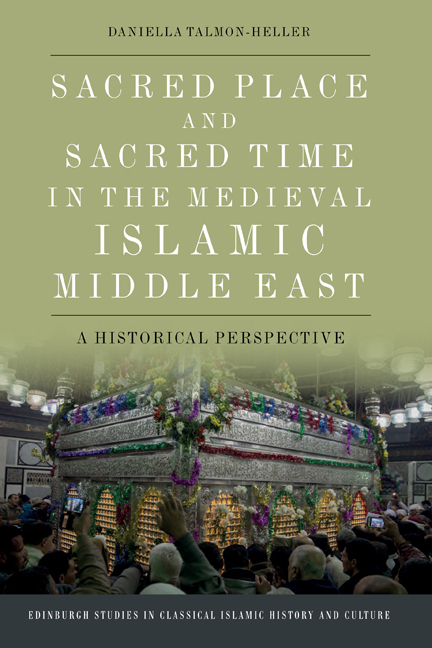Book contents
- Frontmatter
- Contents
- List of Figures
- Acknowledgements
- Map of the Middle East
- Introduction
- 1 Etic Concepts and Emic Terms
- 2 The State of the Art
- Part One A Sacred Place: The Shrine of al-Husayn’s Head
- Part Two A Sacred Time: The Month of Rajab
- Final Comments: Spacial and Temporal Sanctity
- Works Cited
- Index
14 - Summary
Published online by Cambridge University Press: 17 October 2020
- Frontmatter
- Contents
- List of Figures
- Acknowledgements
- Map of the Middle East
- Introduction
- 1 Etic Concepts and Emic Terms
- 2 The State of the Art
- Part One A Sacred Place: The Shrine of al-Husayn’s Head
- Part Two A Sacred Time: The Month of Rajab
- Final Comments: Spacial and Temporal Sanctity
- Works Cited
- Index
Summary
A shrine in the peripheral town of Ascalon, on the Mediterranean coast of Palestine, has for the past millennium marked the burial place of the head of al-Husayn b. ʿAli, the martyr of Karbala. It was venerated by Ismaʿili, Imami and Sunni Muslims, despite disagreements over the itinerary and whereabouts of al-Husayn's severed head, al-Husayn's role and the meaning of his martyrdom, and the very sanctification of tombs and relics.
The narrative claiming the head's burial or reburial in Ascalon is outlined in a long inscription from 484/1091, commissioned by the Fatimid vizier Badr al-Din al-Jamali. Whether mainly intended to promote the vizier's own reputation, strenghthen the Fatimids’ hold on the Syrian littoral, bolster Ismaʿilism, or advance an ecumenical religious program revolving around the beloved grandson of the Prophet Muhammad, the ‘discovery’ of a relic of the son of Fatima – the purported ancestor of the Fatimids – served the dynasty's claim to spiritual leadership and imperial rule. The (re-)burial of the head entailed the construction of a grand new mosque-shrine in extra muros Ascalon. It was designed to host both formal Friday prayers and ziyāras by admirers of al-Husayn. Whether it was actually at the time regarded as an institution that represents the hegemonic religious system and its formal ‘great tradition’ (à la Mircea Eliade and Robert Redfield), or as a place rooted in the local lore of the periphery and an outgrowth of its popular tradition (à la Victor Turner), or somewhere on the continuum between the two (à la Erik Cohen), is impossible to say.
Notwithstanding the lack of evidence as to the prior existence of a Husayni mausoleum or cult in Ascalon, the reception of Badr al-Jamali's ‘invented tradition’ may be tied to the fact that the shrine was built on what was already hallowed ground in several respects. First, Ascalon was known as a thaghr (garrison town) from the era of the great conquests. Residing in the city for the sake of defending Muslim territory was a prestigious and rewarding religious undertaking known as murābaṭa under the Umayyads and early Abbasids. Second, the new mashhad stood on the site of a fourthcentury Byzantine sanctuary similarly dedicated to beheaded saints.
- Type
- Chapter
- Information
- Sacred Place and Sacred Time in the Medieval Islamic Middle EastA Historical Perspective, pp. 119 - 124Publisher: Edinburgh University PressPrint publication year: 2020



